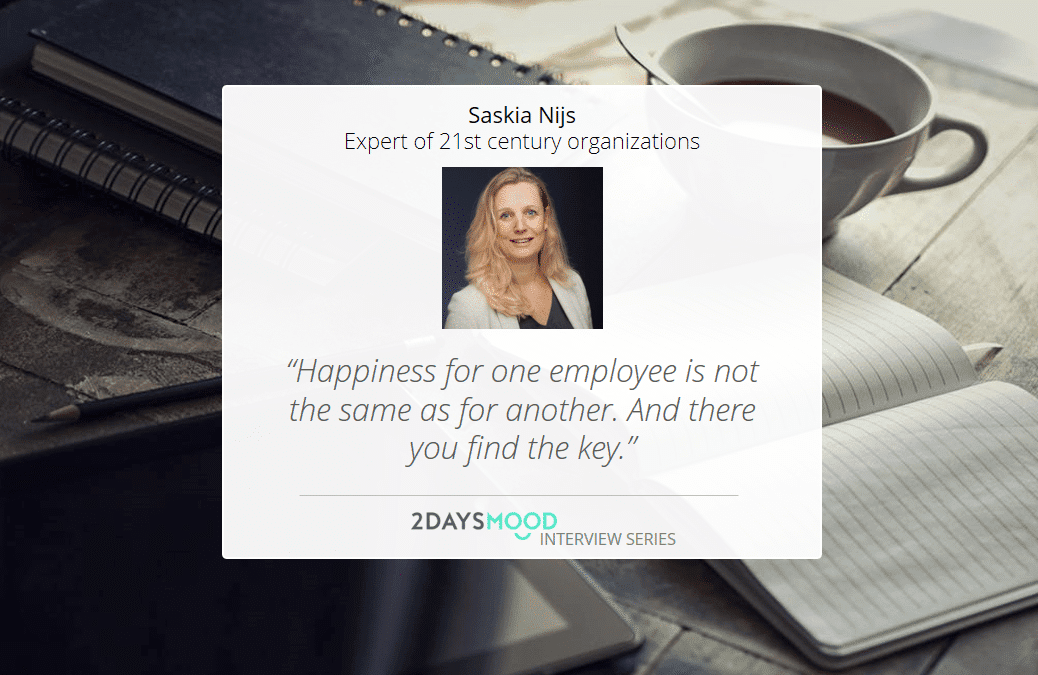2daysmood Interview Series with Saskia Nijs

By Robin van der Meulen | 27/02/2017
Saskia Nijs was always interested in the way organizations work, but her fascination for the relationship between employer and employee really got started when she worked for Microsoft and was part of the team that implemented the New Way of Working in the organization. She got triggered about the fact that employees in a lot of organizations are being asked to do things differently, while systems and structures remain the same. This led to Saskia’s PhD research that aims to discover what organizations have to facilitate in order to have employees use their full potential, which is leading to innovation & growth.
Happiness at work. Is it possible? Is it valuable? How do people in your organization look at happiness on the work floor?
Saskia: “It’s definitely possible! When people work, they all want to feel good about it. And feeling good about their contribution to the organization, already creates a feeling of happiness on itself. However, when people don’t feel recognized, or don’t have sufficient autonomy, their commitment to their contribution can drop. Another important factor is the understanding of the higher purpose and vision of the organization – the more connection, the better people feel at work.”
Menno: “And in your experience, how do people look at happiness at work themselves?”
Saskia: “It differs from person to person. Happiness for one employee is not the same as for another. And there you find the key. There is no such thing as ‘the’ employees. But in order to work in a happy environment, it is crucial that companies start to ASK. Asking a question is the most powerful tool in organizational change.
Different generations have different expectations from their employers. What is the most significant difference you see between the expectation of the younger generations compared to the older ones?
Saskia: “The difference between generations become more visible in various topics. A good example is remote work. There often is a claim that it is the younger generation that wants to be able to work remotely, but interestingly it is the older generation that make more use of it. This seems to be related to the tendency of the younger generation to be more motivated to invest in personal relationships at work and having more personal goals within your professional life. Another important difference is expectation regarding your personal influence. The younger generation wants be heard and taken seriously. They expect to be approach with questions instead of instructions. And I believe this is also possible and realistic, as the younger generation also knows more than then we knew when we started working. It’s mostly the leadership teams that need to get more comfortable with asking questions instead of sending messages.”
Employee Engagement is a term that is widely used, but oftentimes interpreted differently. In your opinion, what should we be talking about when we discuss Employee Engagement?
Saskia: “Creating real engagement among employees is about making it easy to feel good and to contribute. The result is that people pro-actively and committedly take action to add value to your customers, product and brand. That employees do things for the common interest of the organization. On a general level, this seems to be harder to achieve when organizations are bigger.”
Menno: “Would you have any advice for organizations that struggle with the topic?”
Saskia: “It seems to be critical that people’s tasks and responsibilities are aligned with their skills and expertise. Feeling that your capacities and talents are put to use is both good for the organization and for the employee engagement, a clear win-win!”
HR Technology is evolving rapidly. Which HR Tech do you expect to have the biggest impact on your organization in 2017?
Saskia: “I don’t think it is particular technology that will have the most impact, what will incur the most change is the way we use technology. This is especially true for data. There is so much data out there that is not being used. And as it’s not being used, capturing data is likewise not developed to its full potential. Take exit interview for example. Conducting an exit interview with every employee that leaves the organization truly is invaluable. It reveals so much about the culture, wellbeing and engagement of employees. Nonetheless, most organizations fail to consistently hold exit interviews. I believe the biggest change in 2017 will be the increased value we get from the data, which will lead to capturing more data and increased use of HR technology that we already have.”